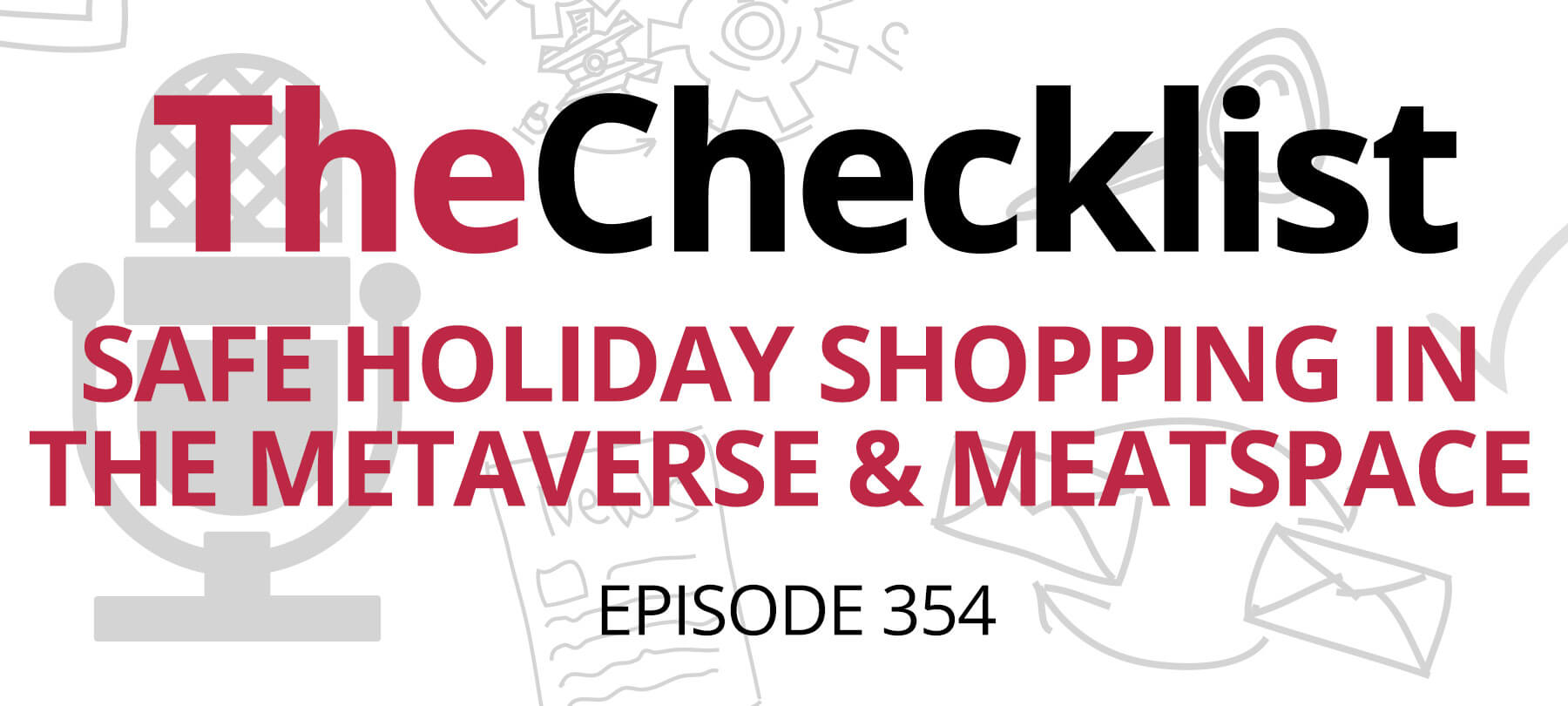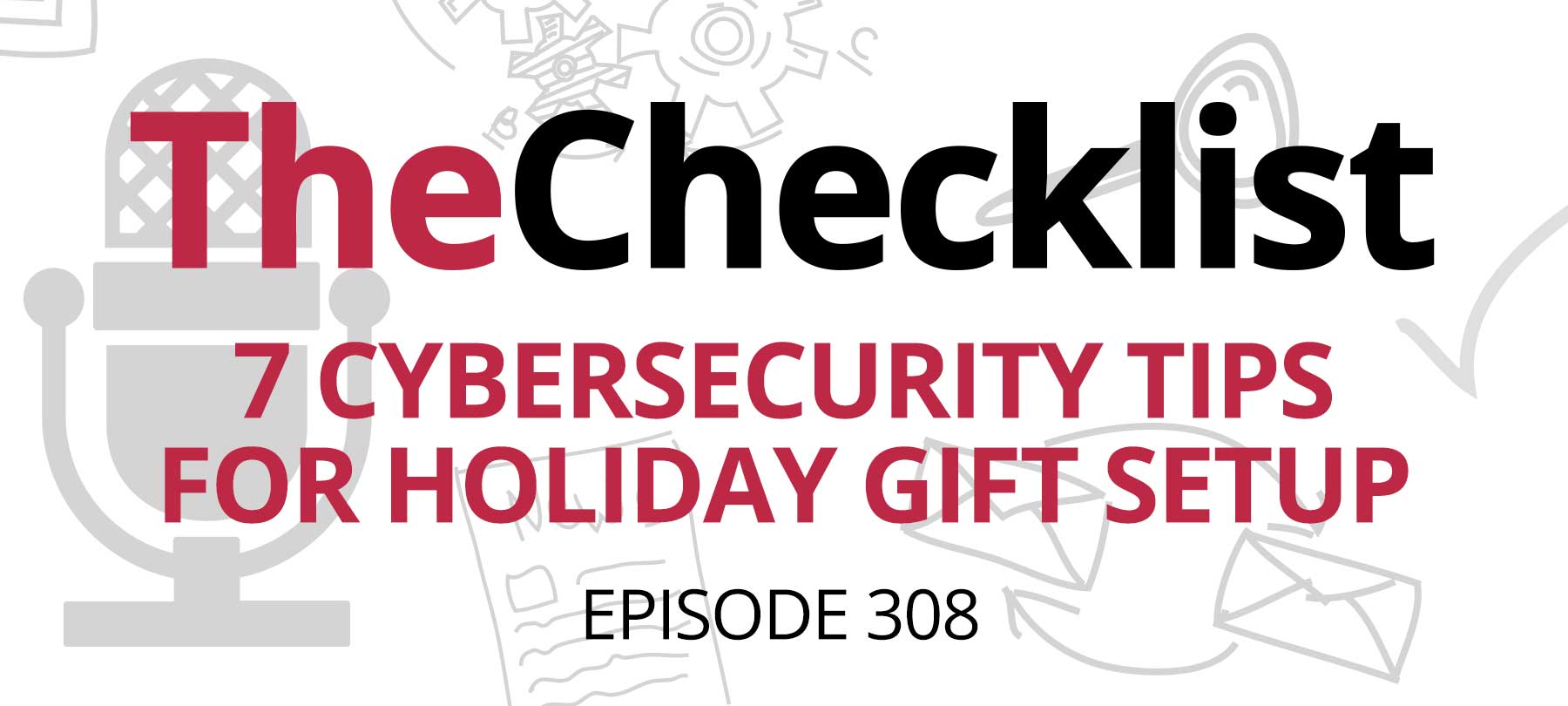- Keep your security software up-to-date.
- Shopping on mobile devices.
- Use one credit card for online purchases.
- Too good to be true deals?
- Shop on secure networks and avoid public wi-fi.
Welcome! On our episode for today, we’re looking ahead to that most exciting and joyful time of the year: the holidays. As winter approaches for the Northern Hemisphere, many of us are already thinking about to our gift shopping for holidays like Christmas. Of course, in years past, we would all climb into our cars and head down to a big shopping mall — or the local toy store — to pick up everything on Santa’s list. However, the Internet has reshaped the entire holiday shopping experience, and with annual events like Cyber Monday, more and more people are buying gifts online. In fact, it’s the estimation that last year over 120 million people took part in Cyber Monday.
That’s quite a lot of gift shopping — and also quite a lot of opportunities for something to go wrong. While shopping online is certainly more convenient, it also carries with it some risks regarding security and privacy. It’s important to take steps to protect yourself from any of the bad actors on the web looking to use your shopping as an opportunity for personal profit. From websites that aren’t what they appear to be to insecure connections, there’s a lot to keep an eye out for.
However, that doesn’t mean your holiday shopping should be a tense or stressful experience on the web! On the contrary, with a few precautions, buying products online is safe and easy. Now, we’re going to be taking a closer look at five ways you can keep yourself safe while shopping for the perfect gifts. Let’s dive right in with the first big step you should take before you start crossing items off your list.
Keep your security software up-to-date. It makes sense that this should be the first step you take, right? You don’t leave the house without locking up, just like we don’t travel to other countries without the proper vaccinations. Before you start your web shopping, ensure that all the software you’ll use is up to date. You’ll want to update your browser of choice, whether it’s Safari, Chrome, or other software, to take advantage of their latest security patches. Ensure your local anti-malware software is up to date as well, just in case you stray onto an untrustworthy site that could be risky. While the chances of that might seem low, it’s always better to prepare for the worst than hope for the best when we’re looking at secure online shopping.
Shopping on mobile devices. For those planning to do their shopping on mobile devices, verified and official apps will be your best friends. Many retailers these days, such as Amazon, have developed apps specifically to make purchasing their items easier. Apps can offer a better interface for buying on your mobile device vs using their website in many cases. Just be sure to take a close look at the permissions you grant each app when you install them on your mobile device. Limit their access to anything not strictly necessary for making purchases. This way you can isolate other personal information from apps. Next, let’s think about keeping your payments safe and secure.
Use one credit card for online purchases. If this is an option for you — and we understand that it isn’t possible for everyone — this is the best way to shop on the web. There are a few reasons only to use one card while you’re shopping. First and foremost, it drastically reduces the potential damage if one of your chosen retailers suffers a data breach. Exposing one card is vastly preferable to exposing two, three, or even more methods of payment.
Similarly, always try to avoid using a debit card for your online purchases. Consider the potential for disaster if a malicious party were to gain access to your debit card number! The same goes for using your bank account to make payments. Unless you’re using a payment processor like PayPal linked to your bank, keeping these sensitive financial details hidden and away from the web is the smarter choice.
While limiting your potential exposure in a data breach is smart security, the best outcome is to avoid exposure at all. We’ll talk encryption in a moment, but where you choose to use the selected credit card is just as important. You need to take a close look at the sites from which you’re purchasing items.
Too good to be true deals? Watch out for websites and deals that seem too good to be true! Okay, so it’s true that for many of us, most of our online shopping gets done on sites like Amazon, eBay, and the websites for individual retailers like Macy’s. With Amazon alone raking in over a hundred billion dollars in revenue last year, it’s obvious that we love our online shopping. However, just because there are plenty of favorite sites doesn’t mean there aren’t less popular web destinations for shopping. You know, just like in real life, there are those little “out of the way” stores that always seem to offer something special you can’t find anywhere else.
In real life, you’re never going to walk into one of those stores only to be robbed by the store’s owner. Online, though, you do need to be a little more careful about where you shop. If you uncover a small business website that seems to sell items you’d love to purchase, do some background research first. Use Google to determine if there are reviews for the company or others who’ve interacted with them. Usually, this is an easy way to determine if a site is a sham or not. If the offers on the site seem too good to be true, common sense would say they probably aren’t legitimate.
Nonetheless, there are plenty of independent sellers out there who deserve your business. You might check in on handicraft sites like Etsy for a more secure shopping experience, for example. We know, though, that you may still end up shopping on a smaller website. In addition to considering its reputation, you can also look to see how they handle security on their site. This tip is actually related to a much greater point.
Always look for sites that provide a secure, encrypted connection. Trustworthy retailers all over the web make efforts to protect your information just as you work to safeguard your information too. The best online shopping destinations will use encryption software to ensure no one can intercept sensitive data like your credit card number. There are a few things you’ll want to look for. First is SSL, also called secure socket layers, a form of standard encryption used around the Internet. One of the easiest ways to identify whether a retailer is using SSL is to check the web address. If your shopping cart page begins with “HTTPS” instead of the plain old “HTTP”, then you’re on SSL, and your information is safe.
Some sites which have taken further steps to secure and verify their pages will display their full business name in your browser address bar. This extra identification works across many browsers, so you’ll see it whether you’re in Safari or Firefox. SSL/HTTPS are often accompanied by the image of a locked padlock. Some browsers, like Chrome, will display an unlocked padlock when your connection to a site is definitively insecure. We should all get in the habit of checking for these features to keep our data safe. Of course, a secure connection to the site is just one component of safety. You should also consider what you’re using to make that connection.
Shop on secure networks and avoid public wi-fi. The idea of taking your MacBook to the local coffee shop to do your shopping might seem like a good one. Why not enjoy a pumpkin spice latte at the same time? However, it’s crucial to avoid public networks when purchasing products online. Public Wi-Fi is just that: public. Not only is it very easy for hackers to attempt to view information passed over the network, but it’s practically impossible to tell if your data is being “sniffed.” If you must do your shopping while mobile, use your phone and its carrier network. Shopping at home is ultimately preferable, though. You have a much greater control over the security of your home network and web connection than you do at your local public library or coffee shop. Keep your payment details away from prying eyes on private networks.
So, that’s it — five ways to keep yourself better protected while you’re hunting for the perfect gift around the web this holiday season. Whether you load up a full digital shopping cart on Amazon or spread your purchases among many retailers, these practices can help make you safer. Protecting your identity online isn’t so hard when you know what you need to look for. Stay safe, enjoy your shopping, and enjoy the results during the holidays. Be sure to join us again next time!



